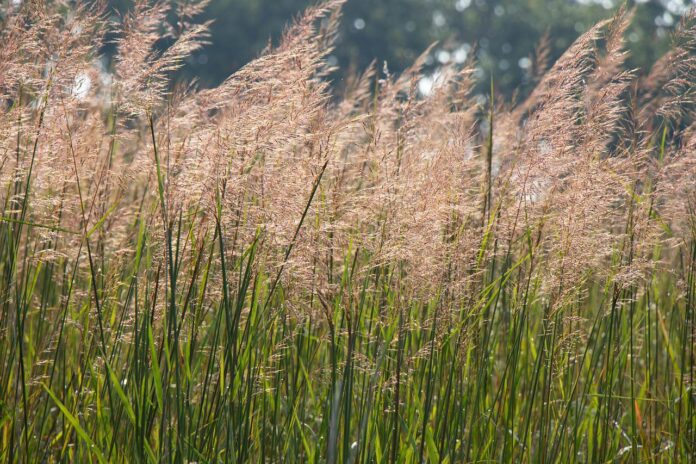By Jimmy Giannone | Columbiana Soil and Water Conservation District
A vast majority of our pastures consist of introduced cool-season grasses such as fescues, Kentucky bluegrass, orchardgrass and timothy. Although orchargrass and timothy can provide exceptional wildlife habitat and grazing potential, native grasses provide great thermal and predatory cover for wildlife, excellent brood rearing habitat for grassland nesting and upland game birds and lots of forage for wildlife and pollinators.
Native benefits
These grasses offer continuous growth and additional biomass during the summer months when our primary introduced grass species slow down. They also have an extensive root system that can reach up to 10 feet deep. This allows them to reach nutrients stored deep in the soil that introduced species cannot reach and recycles those nutrients into the soil improving soil health.
Our native grasslands have been in steady decline with mechanized farming and the invasion of introduced grasses. Many wildlife species rely on this native habitat for nesting and brood rearing, food and shelter. In order to maintain grasslands, frequent disturbance is necessary and grazing these fields helps provide a disturbance that has historically occurred from grazing bison.
Start small
You do not have to turn your entire operation into a native grass grazing system; in fact, depending on the size of your operation, a relatively small paddock is all that is needed to improve forage quality and quantity and give your cool season paddocks a break.
According to the University of Tennessee, to maximize the grazing potential of your pastures, 10-35% of your total pasture acres should be converted to native grasses. Examples of common native grasses that thrive in a grazing operation include big bluestem, indiangrass, switchgrass, little bluestem and gamma grass. The best time to graze these species is June through August when optimal biomass is available which will allow your cool season pastures to rest and stockpile them for winter and early spring forage.
Timing it right
To achieve a successful seeding of native grasses, timing of site preparation and seeding are critical, as well as maintenance the first year or two after establishment. Site preparation using tillage or multiple herbicide applications should begin in late summer/fall (depending on current cover of site and planned seeding method). The mix could then be seeded during the dormant season in January or February, or later in the spring after an additional herbicide application.
The site would likely not be grazed that summer following planting, but instead should be managed to reduce weed competition through high mowing or selective herbicide applications. The following summer, the site will create exceptional grazing opportunity with year three or four providing peak forage.
Seeding challenges
Seeding native grasses is a bit different than seeding introduced species. Common challenges that you may run into are equipment availability and relatively low seeding rates.
Due to the awns on the seeds of a lot of native grass species, they cannot be run through a conventional grain drill because they will not gravity feed down the tubes. They require a native grass drill that has augers in the seed box to help feed the seed. If you go this route and plan to add forbs and legumes to your mix, it is important that your seed be packaged separately so you can put the native grass in the grass box and the forbs in the small seed box.
You can also have good seeding success by doing a dormant season broadcast planting in January or February, which allows the freeze/thaw events to naturally work the seed into the ground. Proper site prep prior to this seeding method is imperative to a successful seeding. Seed should not be planted deeper than 1/4 inch into the soil. Many failed seedings are due to planting too deep, so it is important that you are planting into a firm soil surface at the time of seeding, regardless of your seeding method.
Seeding rates
Depending on the variety of species you choose to plant, seeding rates may be as low as 8 pounds/acre if some additional forbs and legumes are added. Examples of good forbs and legumes that can be added to diversify a mix include but are not limited to partridge pea, Illinois bundleflower, black-eyed susan, wild bergamot, purple coneflower, crimson and alsike clover, showy tick-trefoil, roundhead lespedez and false sunflower.
Diversity
A benefit of diversifying your planting is future input cost where a diverse planting will provide its own sources of nitrogen while a monoculture of grass may require commercial fertilizers to maximize biomass. Grasses are also lower in protein and higher in fiber. Diversifying a mix with some forbs and legumes will improve the nutritional value of forage; however, it may be challenging to perfect an ideal ratio of forbs, legumes and grasses that meet production needs.
Keep in mind that if you want to incorporate native grasses into your rotation, your paddock does not have to be a perfect stand of native grasses to reap the benefits.
It does not take much for cool-season grasses to start showing up in a native grass planting. If desired, you can address them with timed herbicide treatments or by using selective herbicides, or you can have a paddock with a little bit of both native and introduced grasses. Just by adding some diversity and providing availability of species that are actively growing during the summer months will help tremendously give your other paddocks a rest and get you through the summer slump.
If you are interested in learning more about native grass grazing, don’t hesitate to contact your local Natural Resources Conservation Service, Soil and Water Conservation District or Pheasants Forever Biologists.
(Jimmy Giannone is the wildlife/forestry specialist with Columbiana Soil and Water Conservation District. He can be reached at 330-277-2977.)













